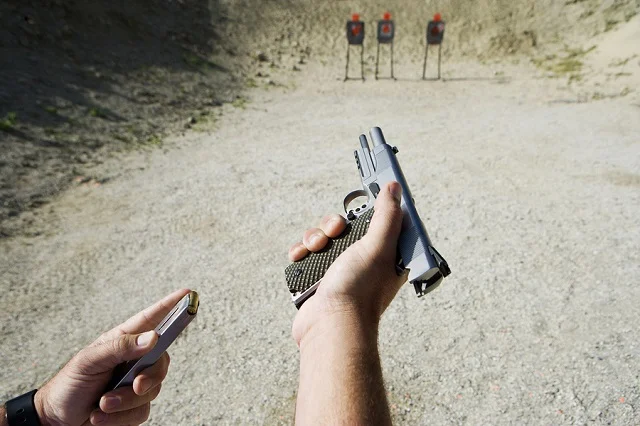Those RIP Rounds We All Keep Hearing About
One of the things that we keep hearing about here at Alien Gear is G2 Research's RIP Rounds. Customers will mention them, fans ask about them on Facebook and YouTube - and we do listen! - and so on. People wonder if they are good carry rounds and so on.
Contrary to popular belief, "RIP" does not stand for "rest in peace" or "requiescat in pacem" ("rest in peace" in Latin") but rather "Radically Invasive Projectile." These bullets have a novel design that promises to be the ultimate tactical nastiness. Hence, we get questions from people about whether or not this is the 9mm ammo to get.
Just like a number of other bullet designs, some folks wonder if they're some sort of ultimate man-stopper. Are they? Well...we're gonna talk about that.
RIP Rounds: What Are They?

Before we get into what RIP rounds are not, let's dig into what they are.
The projectile is all-copper, so there's no lead to be found. (Tactical AND environmentally conscious!) Bullet weight for RIP Rounds 9mm load is 92 grains, which gives them some zip (1250 fps for their 9mm ammo) due to the light weight.
The bullet itself is a copper hollow point, with a crowned nose kind of like Winchester hollow points (Black Talon, Ranger, PDX) though obviously with much sharper points. After casting, horizontal cannelures are cut into the projectile, followed by vertical channels cut into the projectile. This leaves a thin web of copper between the vertical spires that are created by machining the projectile.
I actually spoke with the factory guys at SHOT Show. Their bullets are CNC machined for quality control, so - anything else you might think aside - their process is geared around consistency. They aren't making a novelty round for the sake of it; this is serious ammo.
The intended effect is that when the round enters a fleshy target, the spires peel back and break off into trocars. The trocars slow down rapidly, coming to rest at a relatively shallow depth while the core of the bullet keeps going. However, since copper isn't as dense as lead, it doesn't retain energy as well as a solid lead projectile and thus comes to a stop sooner.
In theory, this means that the core of the bullet gets deeper penetration, but the trocars break off and puncture vital structures like organs, veins and arteries and so on. As the philosopher RW Hubbard observed, it sounds nasty and it pretty much is.
But are they up to the hype?
RIP Rounds Are New But Use Proven Design Elements

Before we go further, it bears mentioning that RIP rounds are basically a new take on the high-velocity hollow point. The external channels and spires are new, but the basic idea - light projectile at high speed - is not the first of its kind.
Let's dive a little more into that.
So, the thing about expanding ammunition is that you're looking for a balance of factors in order to get the effect that you want from the bullet in a squishy target. This isn't new; ammunition makers have been tinkering with this stuff for a long time.
You need enough mass so that enough energy is retained by the projectile as it enters the target to inflict sufficient trauma and penetrate to sufficient depth.
However, you also need enough velocity to get the round to expand; more velocity means more hydraulic pressure as it enters tissue, but - again - you also need a certain minimum threshold of mass in this regard as well. Too light a bullet at too fast a speed goes through soft tissue like Congress goes through the national budget. Too slow, and it just stops barely past the surface. Too heavy a bullet at too slow a speed won't expand because there isn't sufficient hydraulic pressure.
Again, this isn't new information; handgun ammunition makers have been tinkering with this stuff for a long time. What G2 Research did with their RIP rounds is to introduce a new take on an old concept.
What a few ammunition makers figured out is that you could get reliable expansion by making a bullet go a lot faster. How do you do that? Load a lighter projectile and put a bit more powder in it. Some of you might remember or have heard of Super Vel or CorBon. Those ammunition makers figured that same idea decades ago, making light-for-caliber hot loads that would reliably penetrate and expand.
Super Vel started making ammunition in the mid-60s, with their 9mm or .38 Special loads being popular with law enforcement. Unfortunately, tax problems forced the company into shutting their doors in the mid 70s, but companies like CorBon and others followed soon after. They followed the same basic formula, making light-for-caliber +P loads that would penetrate deep and reliably expand.
This is why the 115-grain +P and +P+ loads were the standard for 9mm rounds for so long, despite conventional wisdom favoring heavy-for-caliber (eg 147-grain) loadings instead. They worked more reliably!
Thus, G2 RIP rounds are a variation on a theme, just with external cuts and spires rather than the internal relief cuts commonly found on CorBon and Super Vel ammunition.
Make bullet lighter, it go faster. Cut it, it expands more easily. Makes sense!
So Basically, It's Like A Fragmenting Round
In the broad strokes, RIP rounds are more or less fragmenting or frangible rounds. The hydraulic pressure causes the trocars to break off and the solid core keeps going.
Additionally, since they are solid copper, that means they are monolithic in that they're made of a single material. Mono rounds, as it happens, tend to be long on penetration and short on expansion or the opposite. Jacketed hollow points, on the other hand, tend to strike something of a happy medium.
Most fragmenting rounds tend to penetrate to shallower depths. Not that they don't reach depths in testing that would satisfy the FBI protocol - as you can see in the Lucky Gunner Labs tests - but on the shallow side.
Should that concern you? Is a little less penetration better than a little more?
Actually...it is something you should think about. Here's the thing about gel testing:
Ballistic gelatin isn't the same consistency as human tissue. If anything, it's actually a little firmer than flesh. Ballistic gel is actually the same consistency as the average density of all human tissues, including bone, skin, muscle and so on.
What's been noticed by various agencies is that gel is a good predictor of performance in live tissue, it's not exactly a 1-to-1 ratio of what a bullet does in gel to what it does in tissue. It's more like 3 to 2. In other words, if a bullet penetrates 18 inches in gel, it'll be more like 12 inches in tissue.
Additionally, what the FBI and other agencies have often said is that erring on the side of MORE penetration is better. If nothing else, it punches into the target and does damage.
Does this mean that RIP rounds, fragmenting or frangible rounds won't work in the moment of truth? They probably will. It's just that traditional jacketed hollow points have been designed to work (and have worked) to the parameters that experts have determined most commonly translate to reliable stoppages in the real world.
Should I Carry RIP Rounds?

Alright, now to the nitty-gritty...should you carry RIP rounds? Are they the tactical awesomeness in the .40 or 9mm rounds that most people carry?
The truth is that you should if you think they're best for you. If your gun feeds them reliably, and shoots them accurately, they will do what they're advertised to do. They've only been on the market a couple of years by this point, so there isn't a track record of performance in real-world use to draw on.
What has testing shown, though?
RIP Rounds in most tests don't penetrate as deeply as traditional JHP. The trocars break off as advertised, but they don't make it far into the testing medium.
Again, there isn't a history of case studies and field reports to draw on. What do we know about ammunition performance in real-world shootings that indicates whether or not it would be a suitable self-defense ammunition?
So far, testing of RIP rounds indicates they're better than other novelty ammunition, but inferior to the typical JHP that most experts recommend like Gold Dots, HST and so on.
As to the novelty of the trocars into vital structures...this is where on-paper and real-world collide.
First, testing indicates they don't penetrate deeply. What that means is they only make teeny-tiny flesh wounds, the treatment for which is dress to the wound and keep it clean until it heals. In other words, the trocars are useless.
The part of the bullet that keeps going? That part drills deep enough to be effective. But Gold Dot, HST, Winchester Ranger and Remington Golden Saber do too, and those loads are less expensive, more plentiful, and have a history of working in the line of duty.
So...is it good carry ammunition? If it was all you had and all you could get, it's not the worst thing in the world...but you'd be better off with a conventional quality JHP.











